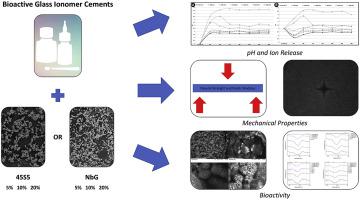International Journal of Adhesion and Adhesives ( IF 3.2 ) Pub Date : 2021-06-10 , DOI: 10.1016/j.ijadhadh.2021.102933 Jaciara Ferreira Moraes , Thais Gomes de Moraes , Fabiola Rodrigues Sampaio Nunes , Edilausson Moreno Carvalho , Gilvanda Silva Nunes , Ceci Nunes Carvalho , Diego Machado Ardenghi , José Bauer

|
Objective
The objective of this study was to evaluate the impact of adding bioactive glasses 45S5 and niobophosphate (NbG) in different concentrations (5, 10 and 20%) of two resin modified glass ionomer cements (RMGIC).
Materials and methods
Two RMGIC were used: Vitro Fil LC (DFL) and Resiglass F (Biodinâmica) they were modified by the addition of two bioactive glasses - 45S5 or NbG. Different concentrations of bioactive glasses (5, 10 and 20 wt%) were mixed with the powder of the RMGICs. The properties evaluated were: alkalinization activity (pH), fluoride (F−), calcium (Ca2+) and phosphate (PO43−) release, flexural strength, flexural modulus, Knoop microhardness and bioactivity. The analyses of the surfaces were examined using SEM and FTIR after storage at 37 °C for 28 days in simulated body fluid (SBF). The data were analyzed using ANOVA One-way (multiple comparison vs control) and Holm-Sidak test (α = 0.05).
Results
The addition of 45S5 increased the pH while the addition of NbG neutralized the pH of the Vitro Fil RMGIC. The RMGIC Resiglass maintained its acidic pH condition in almost all conditions. The addition of the 45S5 and NbG in high concentration increased the release of F−, Ca2+ and PO43− ions. Resiglass did not reduce its mechanical properties with the addition of bioactive glasses (p > 0.05). NbG glass did not alter the mechanical properties of the Vitro Fil (p > 0.05). The addition of the bioactive glasses 45S5 and NbG contributed to the formation of nanoprecursors of hydroxyapatite.
Conclusion
The obtaining of bioactive RMGIC is dependent on the composition of the material. The NbG glass provides a neutralization of the pH, an increase of the ions release and the amount of precipitates without jeopardizing the mechanical properties of the RMGIC.
中文翻译:

通过在树脂改性玻璃离子水门汀中添加生物活性颗粒形成羟基磷灰石纳米前体
客观的
本研究的目的是评估在两种树脂改性玻璃离子水门汀 (RMGIC) 中添加不同浓度(5%、10% 和 20%)的生物活性玻璃 45S5 和铌磷酸盐 (NbG) 的影响。
材料和方法
使用了两种 RMGIC:Vitro Fil LC (DFL) 和 Resiglass F (Biodinâmica),它们通过添加两种生物活性玻璃 - 45S5 或 NbG 进行了修改。将不同浓度的生物活性玻璃(5、10 和 20 wt%)与 RMGIC 粉末混合。评估的特性是:碱化活性(pH)、氟化物(F -)、钙(Ca 2+)和磷酸盐(PO 4 3-)的释放、弯曲强度、弯曲模量、努氏显微硬度和生物活性。在模拟体液 (SBF) 中在 37°C 下储存 28 天后,使用 SEM 和 FTIR 检查表面的分析。使用 ANOVA One-way(多重比较与对照)和 Holm-Sidak 检验(α = 0.05)分析数据。
结果
45S5 的添加提高了 pH 值,而 NbG 的添加中和了 Vitro Fil RMGIC 的 pH 值。RMGIC Resiglass 在几乎所有条件下都保持其酸性 pH 值。添加高浓度的 45S5 和 NbG 增加了 F -、Ca 2+和 PO 4 3-离子的释放。添加生物活性玻璃后,Resiglass 不会降低其机械性能(p > 0.05)。NbG 玻璃不会改变 Vitro Fil 的机械性能 (p > 0.05)。添加生物活性玻璃 45S5 和 NbG 有助于形成羟基磷灰石的纳米前体。
结论
生物活性 RMGIC 的获得取决于材料的组成。NbG 玻璃可中和 pH 值,增加离子释放和沉淀量,而不会危及 RMGIC 的机械性能。











































 京公网安备 11010802027423号
京公网安备 11010802027423号